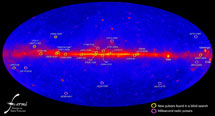
Handy Links
SLAC News Center
SLAC Today
- Subscribe
- Archives: Feb 2006-May 20, 2011
- Archives: May 23, 2011 and later
- Submit Feedback or Story Ideas
- About SLAC Today
SLAC News
Lab News
- Interactions
- Lightsources.org
- ILC NewsLine
- Int'l Science Grid This Week
- Fermilab Today
- Berkeley Lab News
- @brookhaven TODAY
- DOE Pulse
- CERN Courier
- DESY inForm
- US / LHC
SLAC Links
- Emergency
- Safety
- Policy Repository
- Site Entry Form

- Site Maps
- M & O Review
- Computing Status & Calendar
- SLAC Colloquium
- SLACspeak
- SLACspace
- SLAC Logo
- Café Menu
- Flea Market
- Web E-mail
- Marguerite Shuttle
- Discount Commuter Passes
-
Award Reporting Form
- SPIRES
- SciDoc
- Activity Groups
- Library
Stanford
Around the Bay
Fermi Telescope Probes New Gamma-only Pulsars
After only one year of operation, the Fermi Gamma-ray Space Telescope has already outperformed researchers' best expectations. In two papers published in the July 2 edition of Science Express, the researchers reported a new class of pulsar and evidence that helps explain how gamma-ray emission occurs.
The team examined 300 sites of gamma-ray radiation for the study, using data collected by FGST's Large Area Telescope between August 2008 and January 2009 along with data collected by a predecessor, the Energetic Gamma Ray Experiment Telescope. Within these sites they were able to identify 16 new gamma-ray only pulsars.
The LAT, one of the two main instruments on FGST, was assembled at SLAC. The SLAC Instrument Science Operations Center processes all data from the LAT, converting the raw information into a form that scientists can analyze.
"With Fermi we are really opening the window on the possibility of discovering a new class of pulsars, using gamma-ray emissions," said LAT Analysis Coordinator Nicola Omodei, who is visiting SLAC this year from the physics lab INFN in Pisa. "We basically saw something that no one has seen before."
Pulsars are fast-spinning neutron stars: super-dense stellar remnants left in the wake of supernovae. As the neutron stars spin, they emit radio waves from their poles that sweep across the universe like giant searchlights. Radio telescopes on earth or in orbit can detect the pulsars if the beam crosses the earth's path.
So far, more than 1,800 pulsars have been identified by scanning the galaxy for radio waves. In some cases, though, the radio waves can't be seen. Fermi first announced this last October, when researchers identified the first gamma-ray only pulsar.
"Before launch, some predicted that Fermi might uncover a handful of new pulsars during its mission," University of California, Santa Cruz Astronomer Marcus Ziegler said. "To discover 16 in its first five months of operation is really beyond our wildest dreams."
The results also provide insight on how gamma-ray emissions arise. Where radio waves emissions are thought to arise from the poles of a neutron star, the results suggest that gamma rays might originate as far as 300 miles from the star's surface.
Researchers were also able to use the data to closer examine unique objects called millisecond pulsars.
Normally, pulsars lose energy as they spin. As they lose energy, they slow down and stop emitting radiation. But if these aging neutron stars are in close proximity to other stars, something interesting happens: the neutron star's enormous density causes it to accrete material from its neighbors, increasing its mass and restarting its spin.
For reasons that aren't yet clear, these rejuvenated pulsars can spin even faster than their younger brethren. They spin so fast, in fact, that they can complete anywhere from 100 to 1000 full rotations every second.
Before the Fermi gamma-ray telescope, the mechanism of how these millisecond pulsars emitted energy was unclear. But comparing the emission spectrum of the millisecond pulsars to those of gamma-ray only pulsars, researchers found that they were nearly identical.
"Before Fermi launched, it wasn't clear that pulsars with millisecond periods could emit gamma-rays at all," said Lucas Guillemot at the Center for Nuclear Studies in Gradigna, near Bordeaux, France. "Now we know that they do. It's also clear that, despite their differences, both normal and millisecond pulsars share similar mechanisms for emitting gamma-rays."
The Fermi Gamma-ray Space Telescope is an astrophysics and particle physics partnership, developed in collaboration with the U.S. Department of Energy, along with important contributions from academic institutions and partners in France, Germany, Italy, Japan, Sweden, and the U.S.
See also NASA's news release.
—Nicholas Bock
SLAC Today, July 6, 2009
